Security in IoT: Challenges, Threats, and Solutions Report
VerifiedAdded on 2022/10/06
|9
|2620
|12
Report
AI Summary
This report delves into the critical aspects of security within the Internet of Things (IoT), particularly in the context of smart cities. It highlights the increasing importance of security due to the interconnected nature of devices and the sensitive data they collect. The report identifies various security issues, including data collection and transfer vulnerabilities, data storage and processing concerns, and the challenges associated with smart mobility. It discusses the inherent risks associated with the integration of diverse technologies and systems within smart city infrastructures. The report analyzes existing security methods, such as RFID tags, identity management frameworks, ITS security methods, authentication and control systems, and security middleware, while also acknowledging their limitations. It proposes a comprehensive security framework that incorporates a threat index to assess and mitigate risks in IoT environments, considering legal, policy, and security control perspectives. The report emphasizes the need for robust data protection measures, including encryption and auditing, to ensure the confidentiality, integrity, and availability of information in smart city ecosystems. It concludes by underscoring the significance of addressing privacy concerns and the need for continuous improvement in IoT security practices to foster consumer acceptance and facilitate the successful development of smart cities.

Running Head: SECURITY IN IOT
SECURITY IN IOT
Name of the Student:
Name of the University:
Author Note:
SECURITY IN IOT
Name of the Student:
Name of the University:
Author Note:
Paraphrase This Document
Need a fresh take? Get an instant paraphrase of this document with our AI Paraphraser
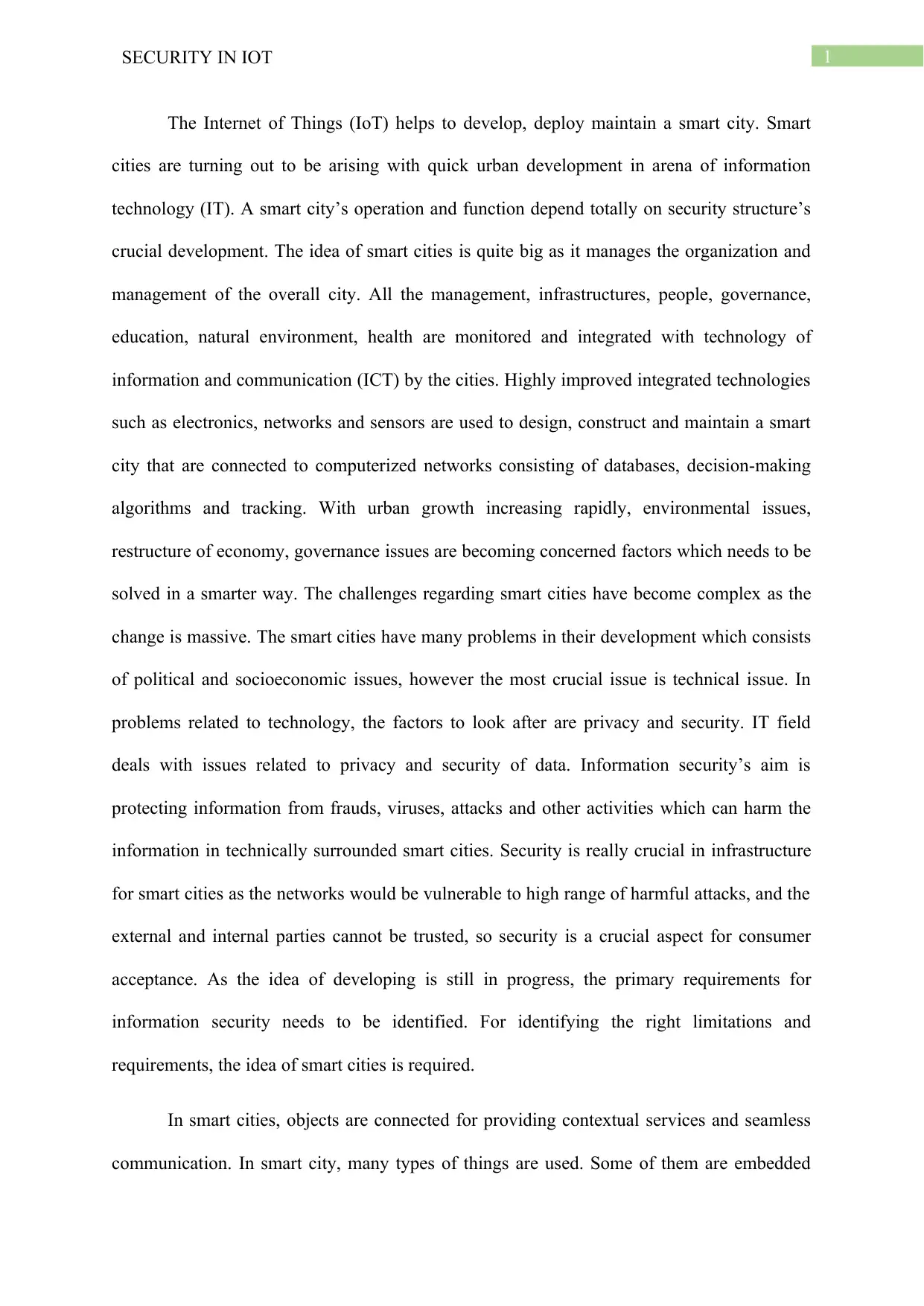
1SECURITY IN IOT
The Internet of Things (IoT) helps to develop, deploy maintain a smart city. Smart
cities are turning out to be arising with quick urban development in arena of information
technology (IT). A smart city’s operation and function depend totally on security structure’s
crucial development. The idea of smart cities is quite big as it manages the organization and
management of the overall city. All the management, infrastructures, people, governance,
education, natural environment, health are monitored and integrated with technology of
information and communication (ICT) by the cities. Highly improved integrated technologies
such as electronics, networks and sensors are used to design, construct and maintain a smart
city that are connected to computerized networks consisting of databases, decision-making
algorithms and tracking. With urban growth increasing rapidly, environmental issues,
restructure of economy, governance issues are becoming concerned factors which needs to be
solved in a smarter way. The challenges regarding smart cities have become complex as the
change is massive. The smart cities have many problems in their development which consists
of political and socioeconomic issues, however the most crucial issue is technical issue. In
problems related to technology, the factors to look after are privacy and security. IT field
deals with issues related to privacy and security of data. Information security’s aim is
protecting information from frauds, viruses, attacks and other activities which can harm the
information in technically surrounded smart cities. Security is really crucial in infrastructure
for smart cities as the networks would be vulnerable to high range of harmful attacks, and the
external and internal parties cannot be trusted, so security is a crucial aspect for consumer
acceptance. As the idea of developing is still in progress, the primary requirements for
information security needs to be identified. For identifying the right limitations and
requirements, the idea of smart cities is required.
In smart cities, objects are connected for providing contextual services and seamless
communication. In smart city, many types of things are used. Some of them are embedded
The Internet of Things (IoT) helps to develop, deploy maintain a smart city. Smart
cities are turning out to be arising with quick urban development in arena of information
technology (IT). A smart city’s operation and function depend totally on security structure’s
crucial development. The idea of smart cities is quite big as it manages the organization and
management of the overall city. All the management, infrastructures, people, governance,
education, natural environment, health are monitored and integrated with technology of
information and communication (ICT) by the cities. Highly improved integrated technologies
such as electronics, networks and sensors are used to design, construct and maintain a smart
city that are connected to computerized networks consisting of databases, decision-making
algorithms and tracking. With urban growth increasing rapidly, environmental issues,
restructure of economy, governance issues are becoming concerned factors which needs to be
solved in a smarter way. The challenges regarding smart cities have become complex as the
change is massive. The smart cities have many problems in their development which consists
of political and socioeconomic issues, however the most crucial issue is technical issue. In
problems related to technology, the factors to look after are privacy and security. IT field
deals with issues related to privacy and security of data. Information security’s aim is
protecting information from frauds, viruses, attacks and other activities which can harm the
information in technically surrounded smart cities. Security is really crucial in infrastructure
for smart cities as the networks would be vulnerable to high range of harmful attacks, and the
external and internal parties cannot be trusted, so security is a crucial aspect for consumer
acceptance. As the idea of developing is still in progress, the primary requirements for
information security needs to be identified. For identifying the right limitations and
requirements, the idea of smart cities is required.
In smart cities, objects are connected for providing contextual services and seamless
communication. In smart city, many types of things are used. Some of them are embedded
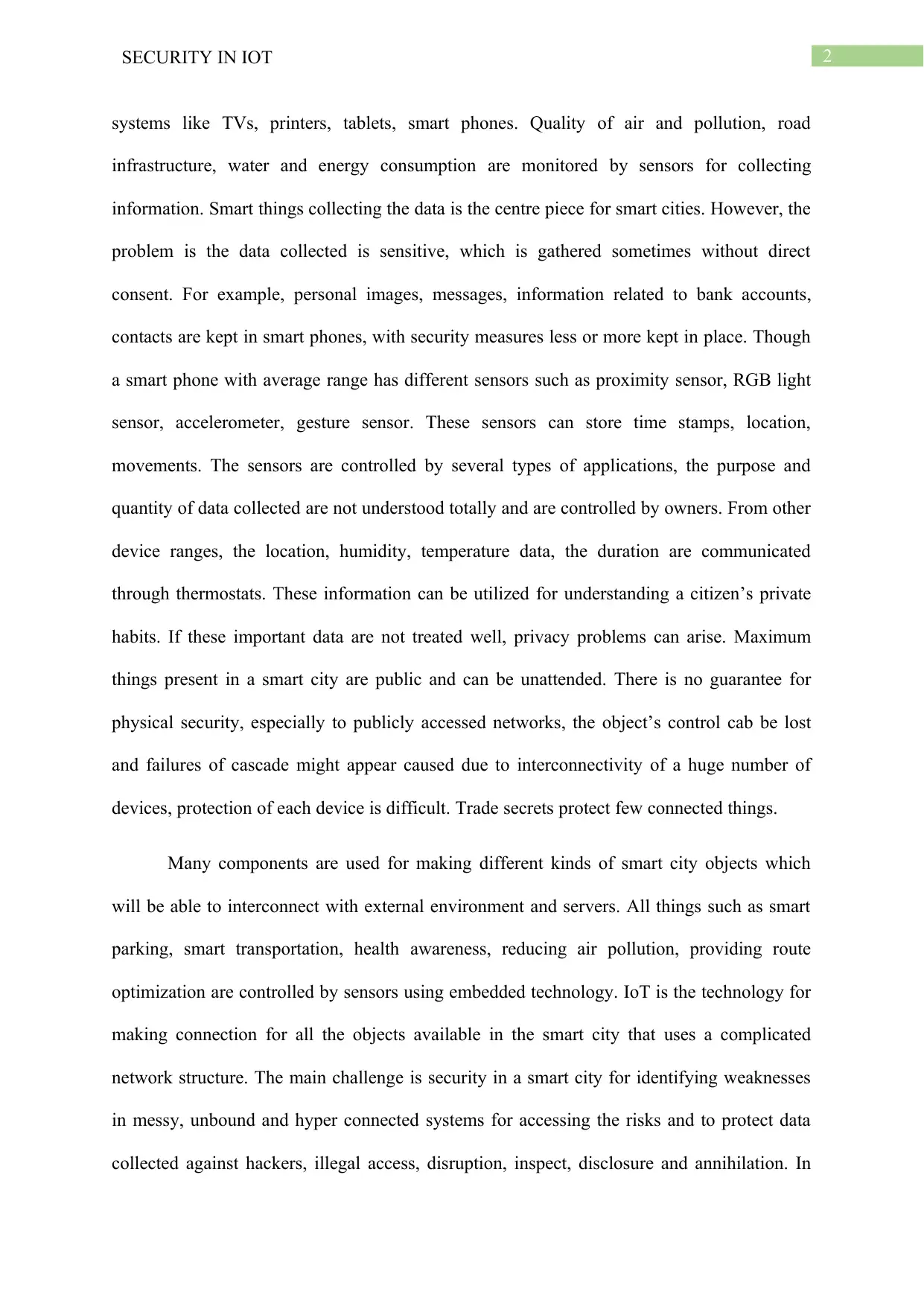
2SECURITY IN IOT
systems like TVs, printers, tablets, smart phones. Quality of air and pollution, road
infrastructure, water and energy consumption are monitored by sensors for collecting
information. Smart things collecting the data is the centre piece for smart cities. However, the
problem is the data collected is sensitive, which is gathered sometimes without direct
consent. For example, personal images, messages, information related to bank accounts,
contacts are kept in smart phones, with security measures less or more kept in place. Though
a smart phone with average range has different sensors such as proximity sensor, RGB light
sensor, accelerometer, gesture sensor. These sensors can store time stamps, location,
movements. The sensors are controlled by several types of applications, the purpose and
quantity of data collected are not understood totally and are controlled by owners. From other
device ranges, the location, humidity, temperature data, the duration are communicated
through thermostats. These information can be utilized for understanding a citizen’s private
habits. If these important data are not treated well, privacy problems can arise. Maximum
things present in a smart city are public and can be unattended. There is no guarantee for
physical security, especially to publicly accessed networks, the object’s control cab be lost
and failures of cascade might appear caused due to interconnectivity of a huge number of
devices, protection of each device is difficult. Trade secrets protect few connected things.
Many components are used for making different kinds of smart city objects which
will be able to interconnect with external environment and servers. All things such as smart
parking, smart transportation, health awareness, reducing air pollution, providing route
optimization are controlled by sensors using embedded technology. IoT is the technology for
making connection for all the objects available in the smart city that uses a complicated
network structure. The main challenge is security in a smart city for identifying weaknesses
in messy, unbound and hyper connected systems for accessing the risks and to protect data
collected against hackers, illegal access, disruption, inspect, disclosure and annihilation. In
systems like TVs, printers, tablets, smart phones. Quality of air and pollution, road
infrastructure, water and energy consumption are monitored by sensors for collecting
information. Smart things collecting the data is the centre piece for smart cities. However, the
problem is the data collected is sensitive, which is gathered sometimes without direct
consent. For example, personal images, messages, information related to bank accounts,
contacts are kept in smart phones, with security measures less or more kept in place. Though
a smart phone with average range has different sensors such as proximity sensor, RGB light
sensor, accelerometer, gesture sensor. These sensors can store time stamps, location,
movements. The sensors are controlled by several types of applications, the purpose and
quantity of data collected are not understood totally and are controlled by owners. From other
device ranges, the location, humidity, temperature data, the duration are communicated
through thermostats. These information can be utilized for understanding a citizen’s private
habits. If these important data are not treated well, privacy problems can arise. Maximum
things present in a smart city are public and can be unattended. There is no guarantee for
physical security, especially to publicly accessed networks, the object’s control cab be lost
and failures of cascade might appear caused due to interconnectivity of a huge number of
devices, protection of each device is difficult. Trade secrets protect few connected things.
Many components are used for making different kinds of smart city objects which
will be able to interconnect with external environment and servers. All things such as smart
parking, smart transportation, health awareness, reducing air pollution, providing route
optimization are controlled by sensors using embedded technology. IoT is the technology for
making connection for all the objects available in the smart city that uses a complicated
network structure. The main challenge is security in a smart city for identifying weaknesses
in messy, unbound and hyper connected systems for accessing the risks and to protect data
collected against hackers, illegal access, disruption, inspect, disclosure and annihilation. In
⊘ This is a preview!⊘
Do you want full access?
Subscribe today to unlock all pages.

Trusted by 1+ million students worldwide

3SECURITY IN IOT
addition, guarantee must be provided for availability, confidentially and integrity for physical
world, communication world and information world. Privacy and security faces extra
challenges in smart cities due to collection of people’s vital information and sensors being
used in environments. It is difficult to analyse such systems for the complexity and
participation of several contributors. The types of security issues faced in a smart city are
security issues in collection and transfer of data, security issues to store and process data and
security issues of smart mobility.
Data is merit provided to anything which is near us. Collected data can be termed as
information. Internet connection in the devices has increased over a last couple of years, for
which there is consistent growth in the networking data. The data value can be lost as quickly
as it can be created and maximum value from the real-time data can be withdrawn. This much
quantity of data creates an opportunity to improve life’s quality in terms of health,
management, education and transportation. In addition, many organizations, governments and
researchers are assisted for solving several issues by inspecting the influx. Data transfer over
diverse networks, technologies, systems, different applications and channels creates security
issues. Solution provided currently is not enough for data protection.
Cloud computing is an important element of smart cities which provides a resilient
and reliable infrastructure to store data for the users and data is processed through remote
servers. During transfer of data to cloud, processioning and controlling of data creates
security challenges as for the non-trustable cloud servers. At first, the data integrity is
important in cloud and auditing is required. Due to cloud environment’s complexity,
sufficient protection might not be provided by implementation of primary security
techniques. Encryption of data of smart city for checking data integrity is not sufficient by
using established cryptographic processes. Moreover, additional storage might be required
which increases costs of data transfer. In addition, analysis of encrypted data along with
addition, guarantee must be provided for availability, confidentially and integrity for physical
world, communication world and information world. Privacy and security faces extra
challenges in smart cities due to collection of people’s vital information and sensors being
used in environments. It is difficult to analyse such systems for the complexity and
participation of several contributors. The types of security issues faced in a smart city are
security issues in collection and transfer of data, security issues to store and process data and
security issues of smart mobility.
Data is merit provided to anything which is near us. Collected data can be termed as
information. Internet connection in the devices has increased over a last couple of years, for
which there is consistent growth in the networking data. The data value can be lost as quickly
as it can be created and maximum value from the real-time data can be withdrawn. This much
quantity of data creates an opportunity to improve life’s quality in terms of health,
management, education and transportation. In addition, many organizations, governments and
researchers are assisted for solving several issues by inspecting the influx. Data transfer over
diverse networks, technologies, systems, different applications and channels creates security
issues. Solution provided currently is not enough for data protection.
Cloud computing is an important element of smart cities which provides a resilient
and reliable infrastructure to store data for the users and data is processed through remote
servers. During transfer of data to cloud, processioning and controlling of data creates
security challenges as for the non-trustable cloud servers. At first, the data integrity is
important in cloud and auditing is required. Due to cloud environment’s complexity,
sufficient protection might not be provided by implementation of primary security
techniques. Encryption of data of smart city for checking data integrity is not sufficient by
using established cryptographic processes. Moreover, additional storage might be required
which increases costs of data transfer. In addition, analysis of encrypted data along with
Paraphrase This Document
Need a fresh take? Get an instant paraphrase of this document with our AI Paraphraser

4SECURITY IN IOT
procession of encrypted data requires additional time and resource, leading in information
delay for applications of smart city and decision making. Accurately interpreting policy for
sharing and accessing data is a challenge regarding security in smart city model.
The process of transforming to smart cities is complex that must be assisted by
promising, reliable procedures, technologies and systems. The transport system of ICT is
integrated by smart mobility. Mobile tools are required for sustainability for developing a
smart city. A set of different benefits are generated by smart mobility for all the stakeholders
and provides several services in respect to transportation with real-time information gathered
from several sources which involves traffic adjustment, reduction in traffic accidents, smart
parking plans, reduction air pollution. Despite of all the advantages, many security issues are
faced through smart mobility integration of different technologies and systems and managing
complexity. Data sharing is part of the system and modifying received and transmitted data in
smart transportation architecture should be stopped. Security halls advantage might be taken
be taken and a security threat might be created as well by the attackers.
One of the security issues in IoT is the issue to collect and transfer data. Information
can be termed as the collected data which is around all of us. The significant data growth in
network is observed due to the devices being connected through internet. Losing data is as
quick as creation of data and real-time data extracts maximum value. This amount of data
helps in improving the life’s quality regarding health, education, management and
transportation. The keyword data cities is used for data representation collected through
applications like smart environment, CCTV cameras and smart transportation. Big data also
plays an important role in development of smart cities. Data sources like machines,, smart
phones, sensors along with several types of applications and technologies are involved in the
production process and data collection in a smart city. Data collection must be in organized
way to make it valuable for community leaders, visitors and dwellers. However transfer of
procession of encrypted data requires additional time and resource, leading in information
delay for applications of smart city and decision making. Accurately interpreting policy for
sharing and accessing data is a challenge regarding security in smart city model.
The process of transforming to smart cities is complex that must be assisted by
promising, reliable procedures, technologies and systems. The transport system of ICT is
integrated by smart mobility. Mobile tools are required for sustainability for developing a
smart city. A set of different benefits are generated by smart mobility for all the stakeholders
and provides several services in respect to transportation with real-time information gathered
from several sources which involves traffic adjustment, reduction in traffic accidents, smart
parking plans, reduction air pollution. Despite of all the advantages, many security issues are
faced through smart mobility integration of different technologies and systems and managing
complexity. Data sharing is part of the system and modifying received and transmitted data in
smart transportation architecture should be stopped. Security halls advantage might be taken
be taken and a security threat might be created as well by the attackers.
One of the security issues in IoT is the issue to collect and transfer data. Information
can be termed as the collected data which is around all of us. The significant data growth in
network is observed due to the devices being connected through internet. Losing data is as
quick as creation of data and real-time data extracts maximum value. This amount of data
helps in improving the life’s quality regarding health, education, management and
transportation. The keyword data cities is used for data representation collected through
applications like smart environment, CCTV cameras and smart transportation. Big data also
plays an important role in development of smart cities. Data sources like machines,, smart
phones, sensors along with several types of applications and technologies are involved in the
production process and data collection in a smart city. Data collection must be in organized
way to make it valuable for community leaders, visitors and dwellers. However transfer of
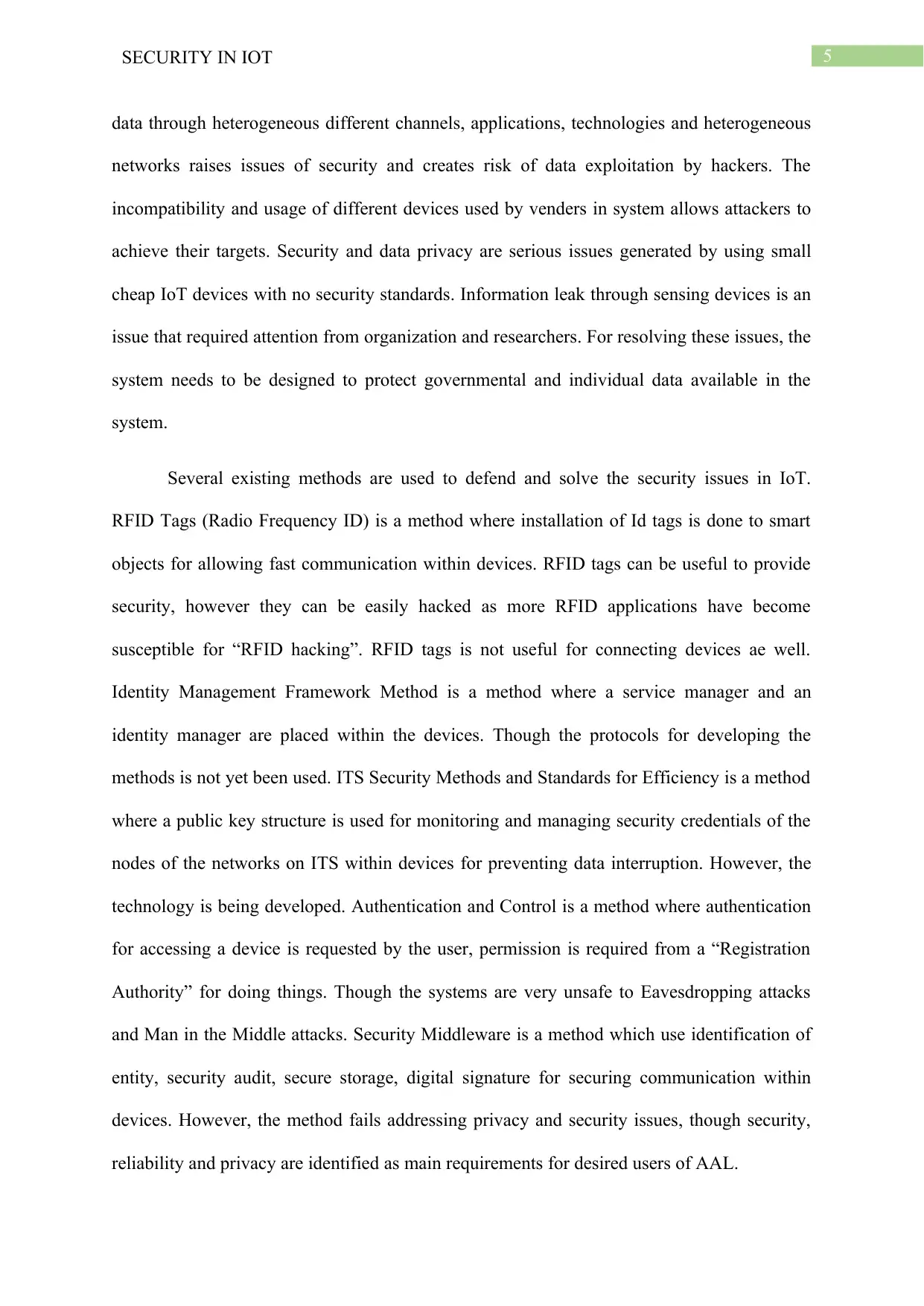
5SECURITY IN IOT
data through heterogeneous different channels, applications, technologies and heterogeneous
networks raises issues of security and creates risk of data exploitation by hackers. The
incompatibility and usage of different devices used by venders in system allows attackers to
achieve their targets. Security and data privacy are serious issues generated by using small
cheap IoT devices with no security standards. Information leak through sensing devices is an
issue that required attention from organization and researchers. For resolving these issues, the
system needs to be designed to protect governmental and individual data available in the
system.
Several existing methods are used to defend and solve the security issues in IoT.
RFID Tags (Radio Frequency ID) is a method where installation of Id tags is done to smart
objects for allowing fast communication within devices. RFID tags can be useful to provide
security, however they can be easily hacked as more RFID applications have become
susceptible for “RFID hacking”. RFID tags is not useful for connecting devices ae well.
Identity Management Framework Method is a method where a service manager and an
identity manager are placed within the devices. Though the protocols for developing the
methods is not yet been used. ITS Security Methods and Standards for Efficiency is a method
where a public key structure is used for monitoring and managing security credentials of the
nodes of the networks on ITS within devices for preventing data interruption. However, the
technology is being developed. Authentication and Control is a method where authentication
for accessing a device is requested by the user, permission is required from a “Registration
Authority” for doing things. Though the systems are very unsafe to Eavesdropping attacks
and Man in the Middle attacks. Security Middleware is a method which use identification of
entity, security audit, secure storage, digital signature for securing communication within
devices. However, the method fails addressing privacy and security issues, though security,
reliability and privacy are identified as main requirements for desired users of AAL.
data through heterogeneous different channels, applications, technologies and heterogeneous
networks raises issues of security and creates risk of data exploitation by hackers. The
incompatibility and usage of different devices used by venders in system allows attackers to
achieve their targets. Security and data privacy are serious issues generated by using small
cheap IoT devices with no security standards. Information leak through sensing devices is an
issue that required attention from organization and researchers. For resolving these issues, the
system needs to be designed to protect governmental and individual data available in the
system.
Several existing methods are used to defend and solve the security issues in IoT.
RFID Tags (Radio Frequency ID) is a method where installation of Id tags is done to smart
objects for allowing fast communication within devices. RFID tags can be useful to provide
security, however they can be easily hacked as more RFID applications have become
susceptible for “RFID hacking”. RFID tags is not useful for connecting devices ae well.
Identity Management Framework Method is a method where a service manager and an
identity manager are placed within the devices. Though the protocols for developing the
methods is not yet been used. ITS Security Methods and Standards for Efficiency is a method
where a public key structure is used for monitoring and managing security credentials of the
nodes of the networks on ITS within devices for preventing data interruption. However, the
technology is being developed. Authentication and Control is a method where authentication
for accessing a device is requested by the user, permission is required from a “Registration
Authority” for doing things. Though the systems are very unsafe to Eavesdropping attacks
and Man in the Middle attacks. Security Middleware is a method which use identification of
entity, security audit, secure storage, digital signature for securing communication within
devices. However, the method fails addressing privacy and security issues, though security,
reliability and privacy are identified as main requirements for desired users of AAL.
⊘ This is a preview!⊘
Do you want full access?
Subscribe today to unlock all pages.

Trusted by 1+ million students worldwide

6SECURITY IN IOT
To address few of the drawbacks of the existing methods, it is recommended to
expand the security framework to solve these issues. Threat index present in this framework
calculates an IoT environment’s vulnerability for threats and attacks. The calculation of this
threat index is done based on legal control, policy control and security control perspectives.
From calculating the threat index, IoT environment’s performance trend can be recognized
and transmitted to user. Calculation of threat index can be done within a specified time period
and comparison can be done with benchmark index thresholds.
To address few of the drawbacks of the existing methods, it is recommended to
expand the security framework to solve these issues. Threat index present in this framework
calculates an IoT environment’s vulnerability for threats and attacks. The calculation of this
threat index is done based on legal control, policy control and security control perspectives.
From calculating the threat index, IoT environment’s performance trend can be recognized
and transmitted to user. Calculation of threat index can be done within a specified time period
and comparison can be done with benchmark index thresholds.
Paraphrase This Document
Need a fresh take? Get an instant paraphrase of this document with our AI Paraphraser
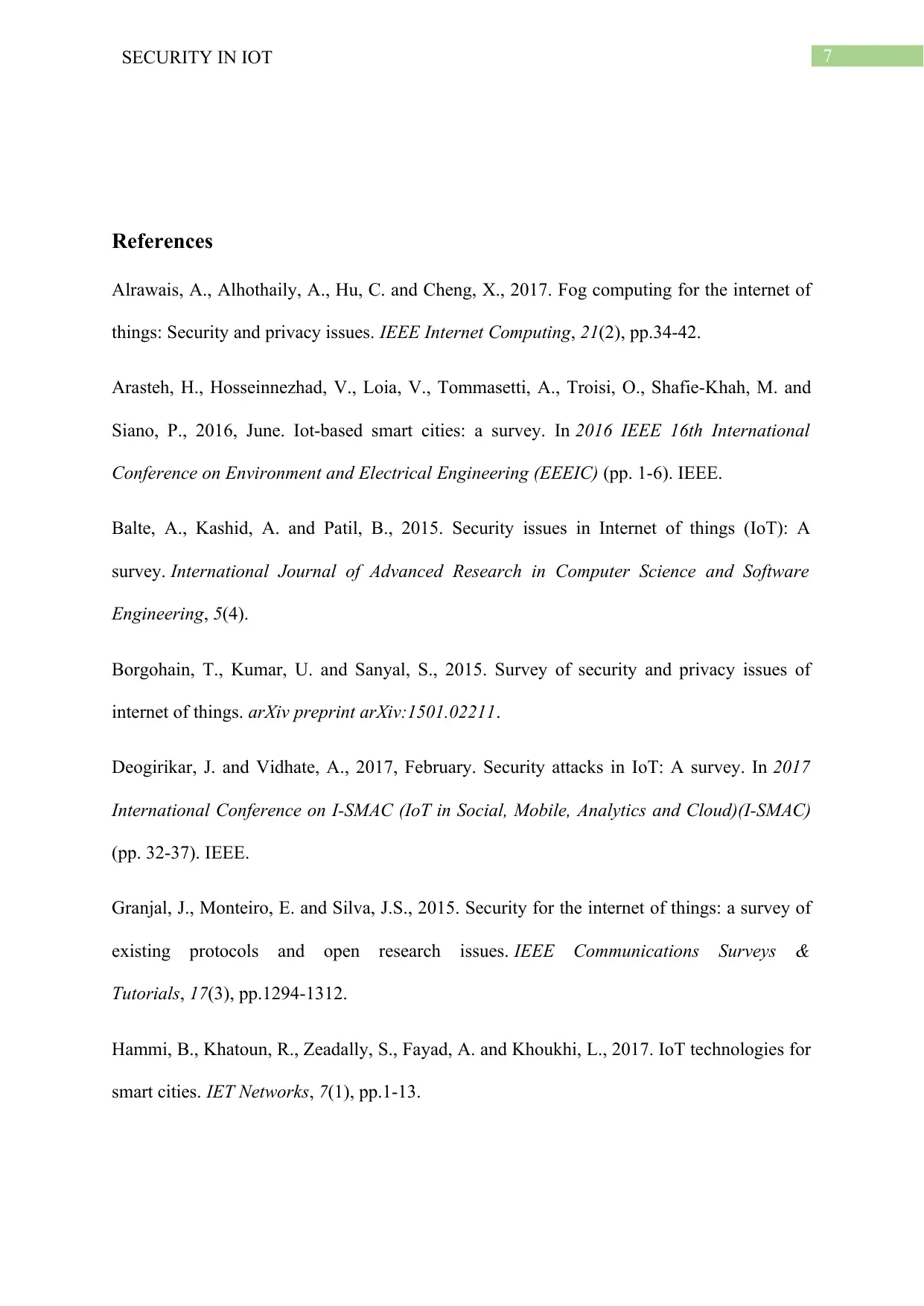
7SECURITY IN IOT
References
Alrawais, A., Alhothaily, A., Hu, C. and Cheng, X., 2017. Fog computing for the internet of
things: Security and privacy issues. IEEE Internet Computing, 21(2), pp.34-42.
Arasteh, H., Hosseinnezhad, V., Loia, V., Tommasetti, A., Troisi, O., Shafie-Khah, M. and
Siano, P., 2016, June. Iot-based smart cities: a survey. In 2016 IEEE 16th International
Conference on Environment and Electrical Engineering (EEEIC) (pp. 1-6). IEEE.
Balte, A., Kashid, A. and Patil, B., 2015. Security issues in Internet of things (IoT): A
survey. International Journal of Advanced Research in Computer Science and Software
Engineering, 5(4).
Borgohain, T., Kumar, U. and Sanyal, S., 2015. Survey of security and privacy issues of
internet of things. arXiv preprint arXiv:1501.02211.
Deogirikar, J. and Vidhate, A., 2017, February. Security attacks in IoT: A survey. In 2017
International Conference on I-SMAC (IoT in Social, Mobile, Analytics and Cloud)(I-SMAC)
(pp. 32-37). IEEE.
Granjal, J., Monteiro, E. and Silva, J.S., 2015. Security for the internet of things: a survey of
existing protocols and open research issues. IEEE Communications Surveys &
Tutorials, 17(3), pp.1294-1312.
Hammi, B., Khatoun, R., Zeadally, S., Fayad, A. and Khoukhi, L., 2017. IoT technologies for
smart cities. IET Networks, 7(1), pp.1-13.
References
Alrawais, A., Alhothaily, A., Hu, C. and Cheng, X., 2017. Fog computing for the internet of
things: Security and privacy issues. IEEE Internet Computing, 21(2), pp.34-42.
Arasteh, H., Hosseinnezhad, V., Loia, V., Tommasetti, A., Troisi, O., Shafie-Khah, M. and
Siano, P., 2016, June. Iot-based smart cities: a survey. In 2016 IEEE 16th International
Conference on Environment and Electrical Engineering (EEEIC) (pp. 1-6). IEEE.
Balte, A., Kashid, A. and Patil, B., 2015. Security issues in Internet of things (IoT): A
survey. International Journal of Advanced Research in Computer Science and Software
Engineering, 5(4).
Borgohain, T., Kumar, U. and Sanyal, S., 2015. Survey of security and privacy issues of
internet of things. arXiv preprint arXiv:1501.02211.
Deogirikar, J. and Vidhate, A., 2017, February. Security attacks in IoT: A survey. In 2017
International Conference on I-SMAC (IoT in Social, Mobile, Analytics and Cloud)(I-SMAC)
(pp. 32-37). IEEE.
Granjal, J., Monteiro, E. and Silva, J.S., 2015. Security for the internet of things: a survey of
existing protocols and open research issues. IEEE Communications Surveys &
Tutorials, 17(3), pp.1294-1312.
Hammi, B., Khatoun, R., Zeadally, S., Fayad, A. and Khoukhi, L., 2017. IoT technologies for
smart cities. IET Networks, 7(1), pp.1-13.
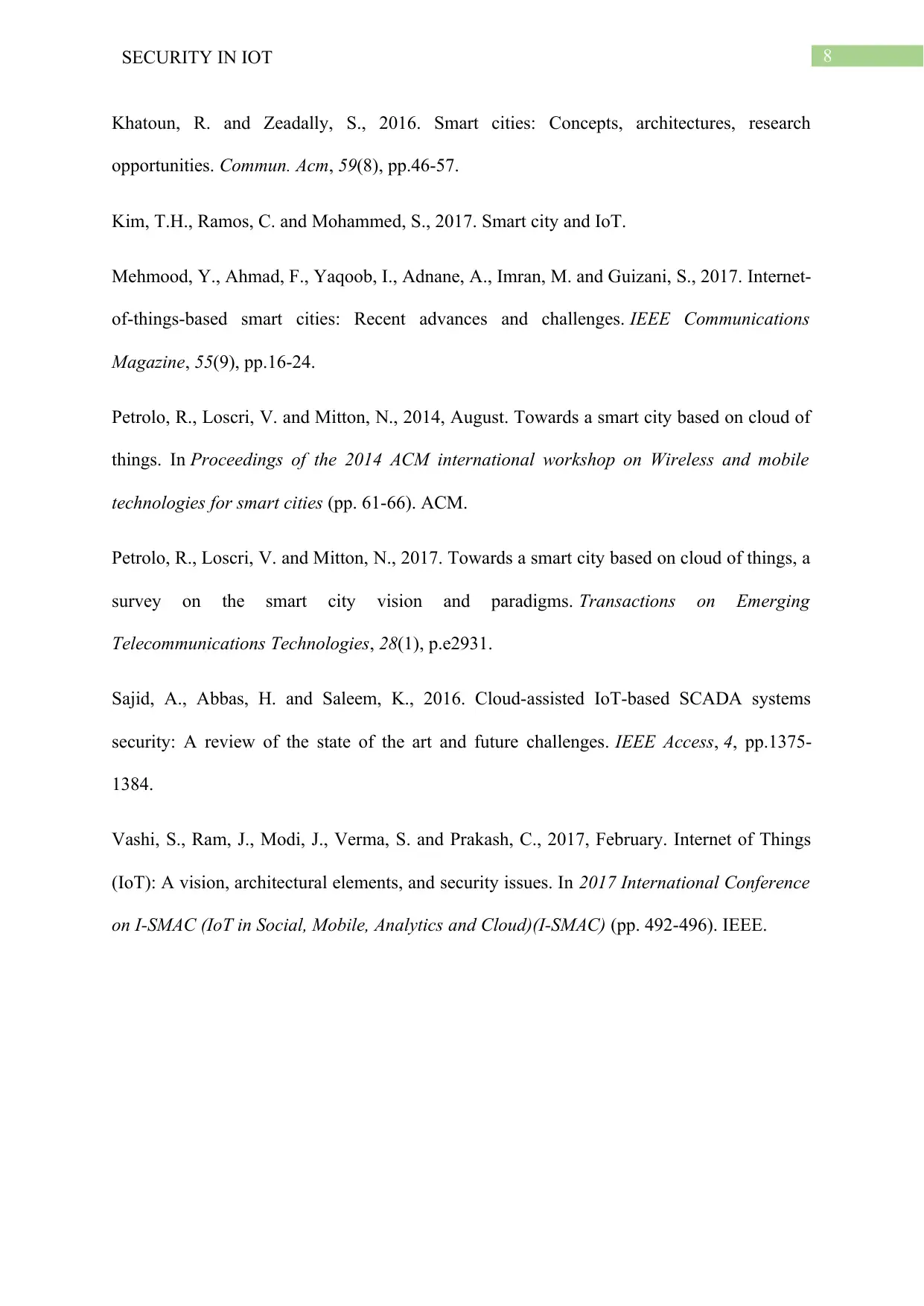
8SECURITY IN IOT
Khatoun, R. and Zeadally, S., 2016. Smart cities: Concepts, architectures, research
opportunities. Commun. Acm, 59(8), pp.46-57.
Kim, T.H., Ramos, C. and Mohammed, S., 2017. Smart city and IoT.
Mehmood, Y., Ahmad, F., Yaqoob, I., Adnane, A., Imran, M. and Guizani, S., 2017. Internet-
of-things-based smart cities: Recent advances and challenges. IEEE Communications
Magazine, 55(9), pp.16-24.
Petrolo, R., Loscri, V. and Mitton, N., 2014, August. Towards a smart city based on cloud of
things. In Proceedings of the 2014 ACM international workshop on Wireless and mobile
technologies for smart cities (pp. 61-66). ACM.
Petrolo, R., Loscri, V. and Mitton, N., 2017. Towards a smart city based on cloud of things, a
survey on the smart city vision and paradigms. Transactions on Emerging
Telecommunications Technologies, 28(1), p.e2931.
Sajid, A., Abbas, H. and Saleem, K., 2016. Cloud-assisted IoT-based SCADA systems
security: A review of the state of the art and future challenges. IEEE Access, 4, pp.1375-
1384.
Vashi, S., Ram, J., Modi, J., Verma, S. and Prakash, C., 2017, February. Internet of Things
(IoT): A vision, architectural elements, and security issues. In 2017 International Conference
on I-SMAC (IoT in Social, Mobile, Analytics and Cloud)(I-SMAC) (pp. 492-496). IEEE.
Khatoun, R. and Zeadally, S., 2016. Smart cities: Concepts, architectures, research
opportunities. Commun. Acm, 59(8), pp.46-57.
Kim, T.H., Ramos, C. and Mohammed, S., 2017. Smart city and IoT.
Mehmood, Y., Ahmad, F., Yaqoob, I., Adnane, A., Imran, M. and Guizani, S., 2017. Internet-
of-things-based smart cities: Recent advances and challenges. IEEE Communications
Magazine, 55(9), pp.16-24.
Petrolo, R., Loscri, V. and Mitton, N., 2014, August. Towards a smart city based on cloud of
things. In Proceedings of the 2014 ACM international workshop on Wireless and mobile
technologies for smart cities (pp. 61-66). ACM.
Petrolo, R., Loscri, V. and Mitton, N., 2017. Towards a smart city based on cloud of things, a
survey on the smart city vision and paradigms. Transactions on Emerging
Telecommunications Technologies, 28(1), p.e2931.
Sajid, A., Abbas, H. and Saleem, K., 2016. Cloud-assisted IoT-based SCADA systems
security: A review of the state of the art and future challenges. IEEE Access, 4, pp.1375-
1384.
Vashi, S., Ram, J., Modi, J., Verma, S. and Prakash, C., 2017, February. Internet of Things
(IoT): A vision, architectural elements, and security issues. In 2017 International Conference
on I-SMAC (IoT in Social, Mobile, Analytics and Cloud)(I-SMAC) (pp. 492-496). IEEE.
⊘ This is a preview!⊘
Do you want full access?
Subscribe today to unlock all pages.

Trusted by 1+ million students worldwide
1 out of 9
Related Documents
Your All-in-One AI-Powered Toolkit for Academic Success.
+13062052269
info@desklib.com
Available 24*7 on WhatsApp / Email
![[object Object]](/_next/static/media/star-bottom.7253800d.svg)
Unlock your academic potential
Copyright © 2020–2025 A2Z Services. All Rights Reserved. Developed and managed by ZUCOL.




